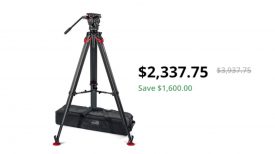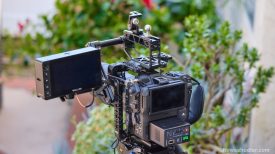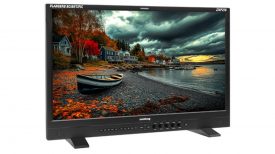There’s always plenty of gear to look out for at NAB, but its very likely that VroomCam’s “green monster” will catch your eye in 2017. The shiny green camera stabilization system is made specifically for 360 cameras, 3D scanners and light field systems and can be controlled either at a distance or it can operate autonomously, without human input.
“The problem with existing dollies is you have to push them around, so there’s a human there,” said Cofounder Gonzalo De La Torre. “That means when the viewer turns around in 360, they would see that person.”
So, the company decided to make its own autonomous 360 camera stabilization system that “doesn’t jiggle or vibrate,” De La Torre said, and can operate either as a rover on the ground or as an aerial system. “And it’s quiet, not like a drone that can really mess up your spatial audio.”
Although most content producers VroomCam has worked with still prefer to control the system manually, it can also be equipped with an intelligent vision system that enables it to understand the environment and follow a host, whether that be a rock star, an athlete or a broadcast journalist, De La Torre said. “But we anticipate there will be a time when producers will want some automation and some manual control.”

In the early days, the system could be controlled by an iOS app, but these days it’s controlled with a more rugged encrypted controller with either a vision system and/or a head-mounted display.
The system is camera agnostic and can work with anything from a six-camera rig of REDs to a Ricoh Theta, but at an entry price of $20,000, it makes for a pricy ride for your Ricoh Theta!
Another key component of the VroomCam system is its ability to mimic human movement so viewers will feel more comfortable in the headset. Although it can go up to 18 miles per hour, De La Torre said that after hundreds of hours of testing, the company has found the “sweet spots” that feel like natural walking, jogging and running.
“The robot knows how to follow at a distance. It knows how to accelerate without moving too fast, how to avoid things and people and change directions when necessary,” De La Torre said. “So, if it’s following Steven Tyler in concert and he starts running toward the camera system, the robot will stop in the right way so the camera doesn’t jiggle back and forth in a way that feels natural to the viewer.”
“When we first got started in VR, people said you couldn’t move the camera,” De La Torre said. “But the reason it hasn’t been embraced is there hasn’t been much 360 locomotive content that’s been done well.”
“Something very similar happened in the early days of the film industry,” he added. “There was a time when cameras were fixed to a specific spot until one day someone decided to move it, even though people told him it was wrong, that it caused headaches. But, low and behold, it created a revolution.”
Although De La Torre couldn’t share many specific details about the system’s tech solutions, he did mention that the stabilization system’s shock system perform well on mildly rugged terrain, like grass and smaller rocks.
The VroomCam can also carry up to 450 pounds of gear, meaning that it can even carry and power its own server with no external cables. It can also last between 24 and 48 hours on a single charge.
The company offers the VroomCam care package and continuous software updates with each purchase, so the system can stay up-to-date and customers will have access to professional help, either remotely or in person, if the system ever malfunctions or gets damaged.
VroomCam is interested in partnering with broadcasters, and De La Torre’s favorite, “guerilla producers” to create content using the VroomCam. “Anyone can sign up to partner with us, and if it’s a good partnership and they don’t have the budget, we’ll try to meet them halfway.”
The VroomCam will be displayed at NAB in Las Vegas in April 2017. For more information, visit the VroomCam website or email info@vroomcam.com.





